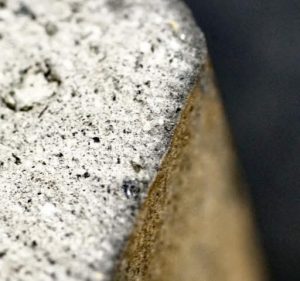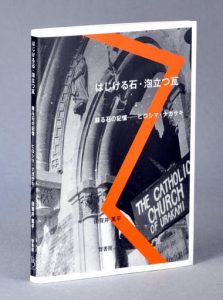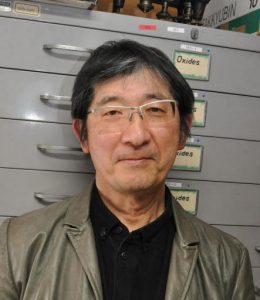Tokuhei Tagai, professor emeritus at University of Tokyo, examines A-bombed roof tiles to analyze force of Hiroshima and Nagasaki A-bombs
Oct. 19, 2020
Tagai’s book concludes “no major difference” in explosive power between two A-bombs
by Yuji Yamamoto, Staff Writer
Tokuhei Tagai, 77, professor emeritus at the University of Tokyo and a specialist in mineralogy, has published a controversial a book about his research into the explosive power of the atomic bombs used on Hiroshima and Nagasaki, conventionally considered to be equivalent to 16 kilotons and 21 kilotons of TNT respectively. Mr. Tagai examined traces of A-bomb thermal rays that remain on A-bombed roof tiles and stones and concluded in his book that “there was no major difference between the explosive power of the Hiroshima and Nagasaki atomic bombs.” According to Mr. Tagai, “It’s important to compare data from various fields and seek the truth.”
The current figures regarding the explosive power of the weapons were confirmed in DS02, a dosimetry system created by an expert committee composed of a team of Japanese and American radiation physicists and other scientists in 2003. Data of residual radiation obtained from A-bombed stones, among other objects, were utilized to devise the system.
Mr. Tagai worked to address the issue from the perspective of the field of mineralogy. Roof tiles exposed to the A-bomb’s high temperatures were, unlike those exposed to heat from fires, melted less than one millimeter in depth only on those surfaces facing the atomic bomb’s detonation. He investigated anew the “melting limit,” which is a measure of how far from the hypocenter roof tiles were melted by the atomic bombing.
A report published by the Science Council of Japan in 1953 indicates that the melting limit in Hiroshima was 600 meters from the hypocenter, based on data collected by a research group led by the late Takeo Watanabe, professor at the University of Tokyo, shortly after the end of World War II. However, according to Mr. Tagai, roof-tile samples gathered by a Hiroshima University investigative team up until the end of 1945 from a spot to the west of the Fukuya Department Store, 700 meters from the hypocenter, also show such traces of melting.
Mr. Tagai then compared a fieldwork notebook, handwritten by Mr. Watanabe, with a draft of the Science Council report. He discovered several errors in notations about distances. Mr. Tagai inferred that the former Hiroshima Prefectural Government building, located 850 meters from the hypocenter, was the actual melting limit, based on a description of “a miniscule amount of melting of roof tile” in the draft.
Mr. Tagai then calculated the linear distance from the detonation of Hiroshima’s atomic bomb, 600 meters above the hypocenter, to Hiroshima’s melting limit, and the linear distance from the detonation of Nagasaki’s atomic bomb, 500 meters above the hypocenter, to Nagasaki’s melting limit. There were no great differences between the two distances. Taking the melting temperature of roof tiles into consideration, he estimated “the explosive power of Hiroshima’s atomic bomb to be 22 kilotons and that of Nagasaki’s atomic bomb 23 kilotons.” Although Nagasaki’s atomic bomb is said to have been one-and-a-half times more powerful than Hiroshima’s atomic bomb, Mr. Tagai believes the difference in the force of the atomic bombs stemmed not from their explosive power but from “the different altitudes of their detonations.”
Kiyoshi Shizuma, 71, professor emeritus at Hiroshima University and a specialist in radiation physics who was engaged in the development of the dosimetry system DS02, said, “These important data were obtained from research into thermal rays, but the conclusion is probably different compared to that drawn from the perspective of radiation physics.” Mr. Tagai said, “There are still many things we don’t exactly understand about the atomic bombs. I hope many people can learn about the significance of exploring these uncertainties using A-bombed stones and rocks.” His comments reflected his wish to make better use in future research of A-bombed roof tiles and stones that were collected carefully by researchers from amid the burned ruins of Hiroshima and Nagasaki.
Published by Tomoshobo, the book Reviving memories of stones: Cracking stones and bubbling roof tiles—The A-bombed cities of Hiroshima and Nagasaki is being sold for the price of 2,640 yen.
(Originally published on October 19, 2020)










